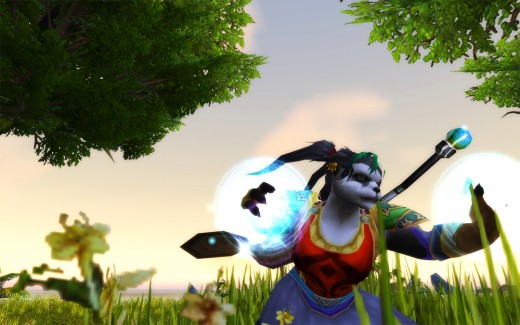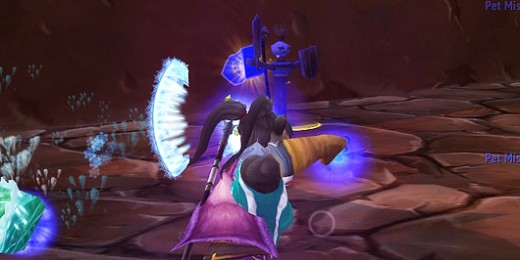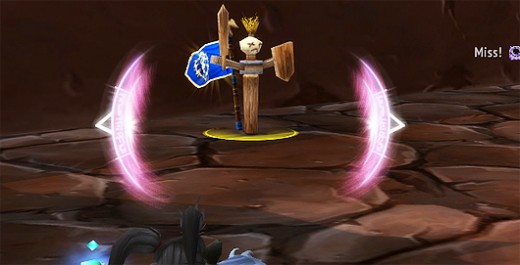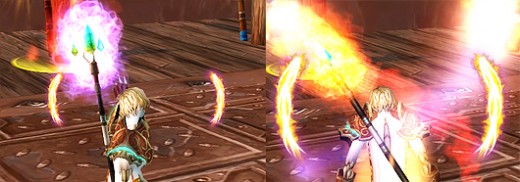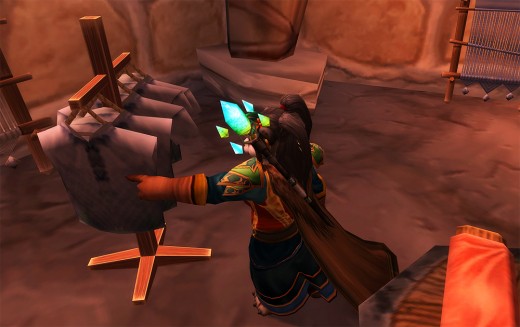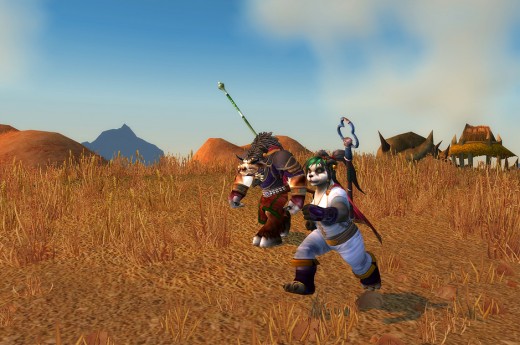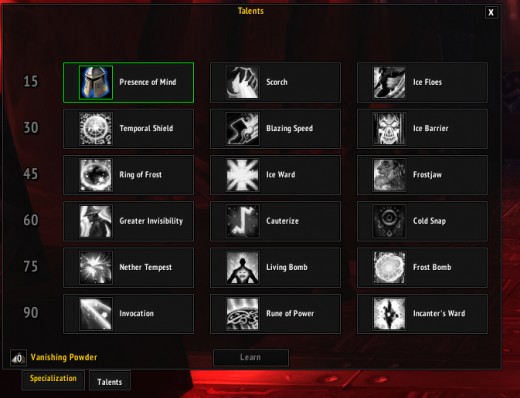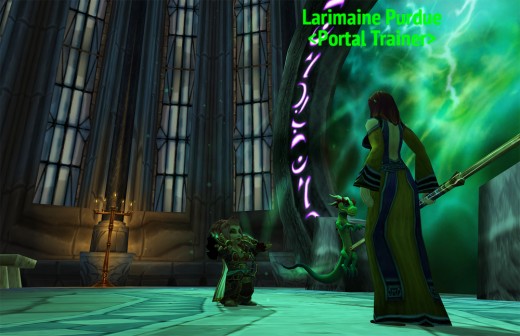This part of the leveling experience starts to dissolve into a series of choices. Do you want to level via quests? What zone? Do you want to do dungeons straight to 60? The same goes for what kinds of things you are doing as a mage. You are learning about not just the basics, but filling out what will be the heart of your rotation at this point.
Spells
You get five spells from levels 21-30 and a lot of their usefulness to you depends on what spec you decide on playing. This is also the point where you gain enough spells to start the basics of a rotation for every spec. At level 22, you gain Ice Lance. This is a low-mana instant cast frost spell, so you can cast it on the move. This spell becomes a lot more powerful/useful for frost mages at level 24, when all mages gain another set of speciality-based spells or effects.
Frost mages get Fingers of Frost, which is a proc off some of your spells (Frostbolt, Frostfire Bolt, Frost Orb, Blizzard or Scorch) that lets you use Deep Freeze (which you will get later) or Ice Lance as if it were frozen. Ice Lance does extra damage because of this. Fingers of Frost can also go up to 2 charges.
Arcane mages get Arcane Missiles. Arcane Missiles have a chance to proc off any damaging spell you cast and can go up to 2 charges. It costs no mana and does more damage depending on how many Arcane Charges you currently have. They are a channeled spell, as well.
Finally, fire mages get a spell called Inferno Blast. This spell replaces Fire Blast for mages and does a couple of different things:
- It has a 100% to crit.
- Because of this, you should be using it to force your Heating Up proc (one crit) to become “Pyroblast!” (two consecutive crits also known as an instant no-mana Pyroblast)
- It spreads all your DoTs to two other targets in 10 yards of the one you are currently targeting - Combustion, Living Bomb, Pyroblast, and Ignite.
- It explodes all other “bomb” effects - Nether Tempest and Frost Bomb (which are talents you can choose later.)
Level 26 is Ice Block. This is a very important defensive ability – Ice Block is classed as an immunity, which is why it is so powerful. It doesn’t absorb damage, but it keeps you from being harmed by it. This means that you can use it for things like saving yourself from falling damage ([Going Down] is a breeze!) and keeping yourself alive during a high damage fight in case a healer dies or you are somewhere you shouldn’t be. It can also be used in a pinch to keep an aggroed mob off of you (if Invisibility is on cooldown) or even to break a fear. However, if you want to do fancy things like that, you have to be able to pop it on and off quickly. Make sure to have this keybound somewhere easy to reach. What this is does is a) allow you to break your cast to pop your Ice Block, meaning you can have a nice hair-trigger cooldown at use and b) tapping your Ice Block macro button a second time cancels the spells so you can use it for part of its duration instead of full. It gives you a lot more control over your block and the situation at hand.
Wrapping up spells at level 28 and 29 are Cone of Cold and Remove Curse. Remove Curse is still an important cleanse spell that mages should learn how to use to save healer’s mana as well as yourself. If you do not use an add-on to handle it (like Decursive) here is a quick mouseover macro that allows you to simply mouse-over and hit your hotkey:
/use [@mouseover,help][@target,help][@player]Remove Curse
What this does is: cleanse your mouseover, and if you aren’t moused over anyone, will cleanse a target if you have one, and failing either of those, cleanse yourself of a curse. Getting good at this will make you indispensable in raids and PVP. At this point, most specs now have a skeleton of a rotation, as well as utility. You have your primary nuke (Arcane Blast, Fireball, Frostbolt), secondary spells (Arcane Missiles, Frostfire Bolt, Pyroblast), and instant-cast fillers (Arcane Barrage, Inferno Blast, Ice Lance). You also have a couple AOE spells (Arcane Explosion, Blizzard) and a couple of utility spells and defensive cooldowns. This is the beginning of your actual life as a DPSer. Your basic rotations should look like:
- Arcane - Arcane Blast, use Arcane Missile procs for mana regen and to complete your stack of Arcane Charges, clear your charges with Arcane Barrage when full (or to AOE). Arcane Explosion if you have lots of low health mobs. Use tier 1 movement talents or Fire Blast when on the move.
- Fire - Fireball is your main spell, if you get a Heating Up proc, use Inferno Blast to force a Pyroblast proc. Use Pyroblast with procs. Use movement talent (preferred is Scorch) when on the go.
- Frost - Use Frostbolt as your nuke, and cast Ice Lance on Fingers of Frost procs. Use your movement talent and Ice Lance when moving.
Talents
Level 30 gives us another talent choice and this tier is the “Survival Tier.”
- Temporal Shield - This is a shield that you can cast at any time (even while stunned, etc) and lasts for 4 seconds. Anything damage gets healed back over 6 seconds after the shield effect fades. This is a good talent for when you know you will be taking a large amount of damage at a particular time.
- Blazing Speed - After taking a melee or spell hit, you can use this spell and give yourself a huge speed boost (preferably away from your attacker) and negate any slowing effects on you as well.
- Ice Barrier - I took this because at low-levels, this is a very beefy damage reduction shield. It’s not very complex but I don’t need complexity. It lasts for a 1 minute if damage does not break it. Very simple and effective.
Glyphs (New!)
At level 25, you gain your first of three major and minor glyph slots. The idea between each kind of glyph slot is that they focus on giving certain kinds of spells a little extra usefulness or flavor. Major Glyphs tend to play around with a lot of secondary spells or cooldowns, giving you a little more width of choice here depending on what kind of play you want to do. Lastly, Minor Glyphs are strictly for fun/flavor or adding bonuses to quality of life spells. There’s not many of them, so it makes choosing them a lot more for “fun.”
What should you be picking for your first glyphs? It is difficult at level 25 since many of the abilities you would be augmenting with a glyph aren’t available to you yet. For sheer usefulness, I picked Glyph of Evocation as my first glyph, so that when I got Evocation, I could use it as a healing cooldown. It is also part of Arcane’s rotation later on. As a fun minor glyph, I picked Glyph of Illusion. To use a glyph, click on the item in your bags. Then press “N” to open up your talents and glyphs panel (if you have not re-bound it, otherwise use the panel on your UI), and apply the glyph from your list to the circle slots.
Note: I am aware that glyphs, even ones for basic abilities, can be very expensive on some servers. As you are leveling, it is not as big of deal as it might seem if you don’t have glyphs right away. If you are short on cash, perhaps buy or gather some herbs and parchment and find a helpful guildie or person on your server to make it for you. Otherwise, you can wait until later to try and buy the glyphs you need. Don’t fret if you don’t have the big money in-game just quite yet. Save it for things like a mount!
Gear
Gear, especially from dungeons and their requisite quests are plentiful now. Slots you won’t really see gear for yet is most head pieces or trinkets. If you are an alt with heirlooms, this is largely meaningless to you! Snagging a cheap Mage deck off the auction house will net you Darkmoon Necklace from the quest. Amulet of the Moon isn’t amazing but it is cheap to make if you are a Jewelcrafter or have a JCer friend and it has INT on it. Reinforced Woolen Shoulders are good for low-level tailors, but if you are doing dungeons, decent shoulders don’t really show up until 30 or so outside of drops. Also absent are hats, rings and definitely trinkets.
Always prioritize for intellect if you can. If you get some gear that has spirit on it, don’t fret. While spirit does zippo for mages, if it also has intellect on it, it is an upgrade. As more gear becomes diversified for healers versus casters, it’ll be considered better if you let healers in your group roll over you on spirit items, but for now, anything that has more intellect should be something you pick. Intellect/stamina gear is fairly plentiful from quests, however. Secondary stats like haste are rarer at this level, even if you do dungeons. However, due to Blizzard re-itemizing a lot of lower-level gear you should be seeing more gear with hit and crit. Now that you are actually receiving gear that may have those stats on it, why don’t we talk about why they are good for you.
Hit is easily the second stat behind Intellect, especially at later levels when you will be constantly fighting mobs that are higher level than you in dungeons. What hit does is determine how much you will miss hitting a mob with spells. The way this stat works, is that it scales down depending on the difference between you and the mobs level. If you look at your character sheet, you will notice things like this: A baddie that is 3 levels higher than you or is “boss level” will require a lot more hit on your gear to cast spells at them reliably. I’m sure you’ve seen a spell miss before – if you run a combat text add-on or use the in-game scrolling combat text, you’ll sometimes see “MISS!” next to the spell icon. That means that math that goes on behind the scenes determined that your spell didn’t actually hit the mob in that encounter. Hit is not as crucial now if you’re questing or doing level-appropriate dungeons/PVP, as most of those mobs will be within 3 levels of you. But any little bit of hit you get on your gear is good and will continue to become more important as you get higher in levels. Crit (rating) is a little more important or less important depending on what spec you choose but for right now, all specs consider it a good thing to have.
Crit increases your chance that you will have a critical strike with your spells. If your spell hits for 300 damage baseline, a crit is that same spell hitting for some portion of its damage over what it already hits for. So you might crit for 700 on an enemy. Intellect already provides a boost to your crit, but straight critical rating on your gear also does as well. Remember that all these things are explained if you mouseover a stat on your character sheet, take a look there sometime. Just remember to look under “General” “Attributes” or “Spell” like in the graphic, Ranged/Melee is for other classes that do Ranged attacks (with their weapons) or melee attacks. “Resistances” isn’t really important right now.
Helpful Tips:
- At level 30, you can pay for the ability to get a second specialization. This allows you to flip between two different specializations on your talents page. Doing this cannot be done in combat! Each spec gets its own set of talents, glyphs and spells.
- Glyphs only need to be learned once. You can swap talents as many times as needed. You do need Vanishing Powder to swap them, however.

